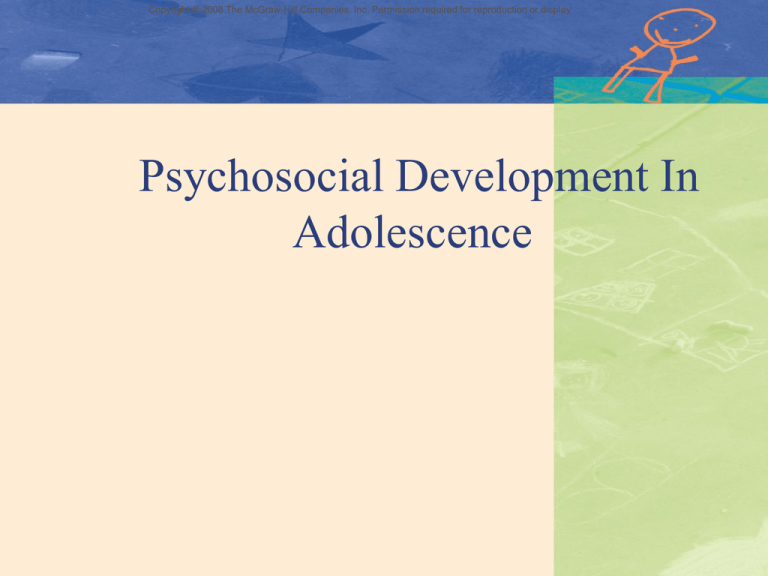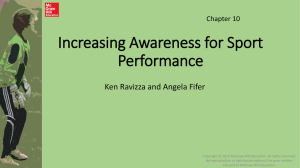
Copyright © 2008 The McGraw-Hill Companies, Inc. Permission required for reproduction or display
Psychosocial Development In
Adolescence
Copyright © 2008 The McGraw-Hill Companies, Inc. Permission required for reproduction or display
The Search for Identity
Erikson: Identity Versus Identity Confusion
Three major issues to be resolved
Occupation
Values
Sexual identity
Psychosocial moratorium
Time out period during adolescence
Copyright © 2008 The McGraw-Hill Companies, Inc. Permission required for reproduction or display
The Search for Identity
Marcia: Identity Status– Crisis and
Commitment
4 identity statuses
Identity achievement
Identity foreclosure
Identity moratorium
Identity diffusion
Copyright © 2008 The McGraw-Hill Companies, Inc. Permission required for reproduction or display
The Search for Identity
Gender Differences in Identity Formation
Women
Identity and intimacy develop together
Self-esteem depends more on connections with
others
Men
Self-esteem tends to be linked with striving for
individual achievement
Copyright © 2008 The McGraw-Hill Companies, Inc. Permission required for reproduction or display
The Search for Identity
Ethnic Factors in Identity Formation
Three aspects of racial/ethnic identity
Connectedness to one’s own racial/ethnic group
Awareness of racism
Embedded achievement
Belief that academic achievement is part of group
identity
Copyright © 2008 The McGraw-Hill Companies, Inc. Permission required for reproduction or display
Gilligan and adolescence
Studied female self-esteem
Prior to adolescence, female and male self-esteem is
similar
During adolescence, female self-esteem drops
Girls tend to doubt themselves more
May be torn between sexual maturity and being the
“nice girl”
Pressure to engage in close cooperative relationships
which may reduce autonomy
Copyright © 2008 The McGraw-Hill Companies, Inc. Permission required for reproduction or display
Girls tend to fight the “feminine ideal” – those
who are too tall tend to slouch, those who are too
short tend to try to look taller. Often become
preoccupied with looks and weight.
Girls tend to report a higher incidence of
depression, dissatisfaction with their bodies,
eating disorders and lower self-esteem
Males tend to have stress at the onset of
adolescence and tend to level off by the time
they are in their teens
Copyright © 2008 The McGraw-Hill Companies, Inc. Permission required for reproduction or display
Emotional Development
Study of emotional dev. in children is fairly
new
Adolescents have become sophisticated at
regulated their emotions
Adolescents are adept at interpreting social
situation as part of the process of managing
emotional displays
Copyright © 2008 The McGraw-Hill Companies, Inc. Permission required for reproduction or display
Emotional Development
Adolescents develop a certain of
expectations
Children begin to break emotional ties with
parents and develop them with friends
Boys will start to regulate (hide) their
emotions.
Adolescents also regulate their emotions
because of their sensitivity to other’s
evaluations of them
Copyright © 2008 The McGraw-Hill Companies, Inc. Permission required for reproduction or display
Emotional Development
During adolescence (as early as age
10)….children begin to realize emotions
aren’t as simple as they thought when they
were children
Boys are less likely to display emotions of
fear as girls are
Displays of empathy also increase during
adolescence
Copyright © 2008 The McGraw-Hill Companies, Inc. Permission required for reproduction or display
Social Development
Begin to form an organized system of personality
traits
Self concept-allows them to add new aspects of
self-esteem (how they feel about their “self”).
As confidence and self-awareness rises-they
begin to form self-identity.
More able to develop friendships that are based
on loyalty and intimacy.
These social milestones occur slowly over time.
Copyright © 2008 The McGraw-Hill Companies, Inc. Permission required for reproduction or display
Moral Development
Many factors can stimulate a person’s
growth through the levels of moral
development.
One most crucial factor is education
Studies indicate that a person’s behavior is
influenced by his or her moral perception
and moral judgments.
`
Copyright © 2008 The McGraw-Hill Companies, Inc. Permission required for reproduction or display
Kohlberg’s Moral Development
Level 3 – Postconventional Level – working
within one’s own personal code of ethics
Stage 5 – Social Contract Orientation – Morals
based on society’s rules, however rules are now
questioned and seen as fallible (early
adolescence)
Stage 6 – Individual Principles and Conscience
Orientation – Morals based on justice, where the
person does what they believe is right
(adolescence)
Copyright © 2008 The McGraw-Hill Companies, Inc. Permission required for reproduction or display
Early Adolescence(12-14)
Rapid Growth
Confused by changes
Curious about final outcome
Personal interest in their own development
Rebellion against home
Acts in way that looks to be considerable
maturity and in the next moment
babyishness
Copyright © 2008 The McGraw-Hill Companies, Inc. Permission required for reproduction or display
Early Adolescence(12-14)
Absorption with close friends of same age and
gender
Moodiness
Sloppiness and Disorder
Establishment of independence of self: Who am
I?
Body-conscious
Strong desire to conform to and be accepted by
peer group
Appearance of Sexual Maturity
Skin problems
Copyright © 2008 The McGraw-Hill Companies, Inc. Permission required for reproduction or display
Early Adolescence(12-14)
Constantly hungry (more than in younger
years)
Companionship at meals and after school
snacks provide dining pleasures)
Sleeps more than during younger years
Sleepy at “getting up” times
Wants to sit up at nights as sign of
increasing maturity
Clash between physiology and culture
Copyright © 2008 The McGraw-Hill Companies, Inc. Permission required for reproduction or display
Early Adolescence(12-14)
Special Characteristics of Boys
Boisterous
Clumsy
Secretive, “clams up” especially around adults or
at home
Aggressive
Dirty-can’t seem to get him near the bathroom
Gain more weight and height than girls
Much talk about sex and girls
Out of house more
Copyright © 2008 The McGraw-Hill Companies, Inc. Permission required for reproduction or display
Early Adolescence (12-14)
Special Characteristics of Girls
Vague and diffuse
Crush on older men
Interested in romantic love
Playacting
Talkative, but not communicative
Giggly!
Copyright © 2008 The McGraw-Hill Companies, Inc. Permission required for reproduction or display
Early Adolescence
Sexuality
Boys express their sexuality through
masturbation
Same-gender sexual encounters are relatively
common
These occur frequently enough to be considered
as a variant of normal sexual development
Questions that adolescents have about erotic
feelings or behaviors toward the same sex need to
be addressed directly and fully.
It is not helpful…to just say…this is no more
then a passing phase.
Copyright © 2008 The McGraw-Hill Companies, Inc. Permission required for reproduction or display
Middle Adolescence (15-16)
Greatest experimental, risk taking time
Drinking, drugs, smoking and sexual experimentation are
often highest interest during the 14-16 years olds
Peer groups gradually give way to one-on-one friendships
and romances
Peer groups tends to be gender-mixed
Dating begins
Less conformity and more tolerance of individual
differences
Omnipotence and Invulnerability are the rule
This results in an inability to link drinking with auto
accidents or drinking with pregnancy or STD’s
Copyright © 2008 The McGraw-Hill Companies, Inc. Permission required for reproduction or display
Middle Adolescence (15-16)
Striving for independence and autonomy is
greatly increased
Parental conflicts occur which need confrontation
and resolution (these are normal and necessary)
Adolescents confide in each other
Sexual development results in unpredictable
surges in sexual drive
Often accompanied by sexual fantasies
Sexuality is a MAJOR preoccupation of the
middle adolescent
Copyright © 2008 The McGraw-Hill Companies, Inc. Permission required for reproduction or display
Middle Adolescence (15-16)
Sexual activity occurs more frequently among
boys than girls
Testosterone increases are found in both boys and
girls but much more abundant in boys
Higher testosterone levels in boys may result in
greater sexual drives, sexual aggressiveness and
more purely physical gratifications
Girls at this age tend to view sexual gratification
as secondary to fulfillment of other needs such as
love, affection, self-esteem and reassurance
Copyright © 2008 The McGraw-Hill Companies, Inc. Permission required for reproduction or display
Late Adolescence (17-18)
Rebellious
Concerned with personal appearance (can’t get
them out of the bathroom)
Moody
Interest in the opposite gender
Establishment of ego identity-”where do I fit into
the world”
Growth finally subsided
Full stature almost attained
Sleep requirements approaching adult level
Copyright © 2008 The McGraw-Hill Companies, Inc. Permission required for reproduction or display
Late Adolescence(17-18)
Food requirement approaching adult level
Companionship when eating
Intimate relation with friend fades
Greater interest in opposite gender
Needs acceptance by society, in job and in
college
Needs parental respect for opinion and
acceptance of maturity
Copyright © 2008 The McGraw-Hill Companies, Inc. Permission required for reproduction or display
Late Adolescence(17-18)
“Whom am I as a vocational being?”
Work opportunities during these years
allow exploration of tentative career
choices
A choice of vocation reinforces the
adolescent’s self-concept and is important
to identify formation
Copyright © 2008 The McGraw-Hill Companies, Inc. Permission required for reproduction or display
Late Adolescence (17-18)
Factors Influencing vocational choice:
Family values
Social class
Socioeconomic conditions
Need for prestige
Vocational Independence
Special Abilities
Motivation
Copyright © 2008 The McGraw-Hill Companies, Inc. Permission required for reproduction or display
Late Adolescence (17-18)
Special Characteristics of Boys
Interest in plans for career
Sexual interest prominent and
demanding
Less interested than girls in
mate seeking
Copyright © 2008 The McGraw-Hill Companies, Inc. Permission required for reproduction or display
Late Adolescence (17-18)
Special Characteristics of Girls
Interest in boys, now directed towards mate
seeking
Absorbed in fantasies of romantic love
Less interested than boys in plans for
career
Sexual interest less demanding than in boys
Copyright © 2008 The McGraw-Hill Companies, Inc. Permission required for reproduction or display
Sexuality
Sexual Orientation and Identity
Sexual orientation
Heterosexual
Homosexual
Attraction or arousal
Behavior
Identity
Bisexual
Copyright © 2008 The McGraw-Hill Companies, Inc. Permission required for reproduction or display
Sexuality
Sexual Orientation and Identity
Origins of sexual orientation
Partly genetic
Chromosomes 7, 8, and 10
Non-genetic factors also play a part
Number of times mother had previously given
birth to boys seems to be a factor
No association between orientation and
emotional or social problems
Copyright © 2008 The McGraw-Hill Companies, Inc. Permission required for reproduction or display
Sexuality
Sexual Orientation and Identity
Homosexual and bisexual identity
development
One model proposes the following sequence
1. Awareness of same-sex attraction (ages 8-11)
2. Same-sex sexual behaviors (ages 12-15)
3. Identification as gay or lesbian (ages 15-18)
4. Disclosure to others (ages 17-19)
5. Development of same-sex romantic relationships
(ages 18-20)
Copyright © 2008 The McGraw-Hill Companies, Inc. Permission required for reproduction or display
Sexuality
Sexual Behavior
77 percent of young people in the U.S. have
had sex by age 20
Average girl has first sexual intercourse at 17,
average boy at 16
African Americans and Latinos tend to begin
sexual activity earlier than white youth
Asian-American youth have a pattern of
delayed sexual activity saving sex for
marriage or adulthood
Copyright © 2008 The McGraw-Hill Companies, Inc. Permission required for reproduction or display
Sexuality
Sexual Behavior
Where do teenagers get information about
sex?
Friends
Parents
Sex education in school
Media
Gives a distorted view, associating sex with fun,
excitement, competition, danger, or violence
Copyright © 2008 The McGraw-Hill Companies, Inc. Permission required for reproduction or display
Relationships with Family and Peers
Is Adolescent Rebellion a Myth?
Only 1 in 5 teenagers fits the pattern
Emotional turmoil
Conflict within the family
Alienation from adult society
Reckless behavior
Rejection of adult values
Copyright © 2008 The McGraw-Hill Companies, Inc. Permission required for reproduction or display
Relationships with Family and Peers
G. Stanley Hall (1904/1916)
Period of “storm and stress”
Efforts to adjust to their changing bodies and
demands of adulthood
Sigmund Freud (1935/1953) and Anna
Freud (1946)
Universal and inevitable rebellion, growing
out of a resurgence of early sexual drives
toward the parents
Copyright © 2008 The McGraw-Hill Companies, Inc. Permission required for reproduction or display
Relationships with Family and Peers
Margaret Mead (1928/1935)
Concluded that when a culture provides a
gradual, serene transition into adulthood,
“storm and stress” is not typical
Most young people feel close to and share
similar opinions with their parents, and value
their parents’ approval
Copyright © 2008 The McGraw-Hill Companies, Inc. Permission required for reproduction or display
Relationships with Family and Peers
Is Adolescent Rebellion a Myth?
Adolescence can be a difficult time for young
people and their parents
Family conflict
Depression
Risky behavior
Mood swings
Copyright © 2008 The McGraw-Hill Companies, Inc. Permission required for reproduction or display
Relationships with Family and Peers
Changing Time Use and Changing
Relationships
Disengagement is not rejection but response
to developmental needs
Cultural variations reflect varying
Needs
Values
Practices
Copyright © 2008 The McGraw-Hill Companies, Inc. Permission required for reproduction or display
Relationships with Family and Peers
Adolescents and Parents
Parents feel mixed emotions about the need to
let go and the desire for their children to be
independent
Tensions can lead to family conflict
Parenting styles influence outcome
Copyright © 2008 The McGraw-Hill Companies, Inc. Permission required for reproduction or display
Relationships with Family and Peers
Adolescents and Parents
Family conflict and individuation
Arguments are usually about mundane personal
matters
Chores
Schoolwork
Dress
Money
Curfews
Dating and friends
Copyright © 2008 The McGraw-Hill Companies, Inc. Permission required for reproduction or display
Relationships with Family and Peers
Adolescents and Parents
Individuation
Adolescent struggle for autonomy and
differentiation, or personal identity
Family conflict is most frequent during early
adolescence, but most intense during
midadolescence
Copyright © 2008 The McGraw-Hill Companies, Inc. Permission required for reproduction or display
Relationships with Family and Peers
Adolescents and Siblings
Adolescents spend more time with peers than
siblings
Sibling relationships become more equal as
they approach high school
Younger siblings still tend to look up to older
ones
Copyright © 2008 The McGraw-Hill Companies, Inc. Permission required for reproduction or display
Relationships with Family and Peers
Peers and Friends
Influence of peers peaks at ages 12 or 13
Declines during middle and late adolescence
Cliques
Structures groups of friends who do things
together
Crowds
Social construction based on reputation, image, or
identity
Copyright © 2008 The McGraw-Hill Companies, Inc. Permission required for reproduction or display
Relationships with Family and Peers
Peers and Friends
Friendships
Become more reciprocal, equal, and stable
Tend to be chosen by
Gender
Race/ethnicity
Have similar academic attitudes and similar levels
of drug use
Copyright © 2008 The McGraw-Hill Companies, Inc. Permission required for reproduction or display
Relationships with Family and Peers
Romantic Relationships
Central part of most adolescents’ social
worlds
Contribute to development of intimacy and
identity
Can entail risks of pregnancy, STDs, and
sometimes sexual victimization
Copyright © 2008 The McGraw-Hill Companies, Inc. Permission required for reproduction or display
Antisocial Behavior and Juvenile Delinquency
Becoming a Delinquent: Genetic and
Neurological Factors
Genes influence 40 to 50 percent of variation
in antisocial behavior
Parents shape prosocial or antisocial behavior
through their responses to basic emotional
needs
Authoritative parenting can help young people
internalize positive standards
Copyright © 2008 The McGraw-Hill Companies, Inc. Permission required for reproduction or display
Antisocial Behavior and Juvenile Delinquency
Becoming a Delinquent: How Family,
Peer, and Community Influences Interact
Family economic circumstances influence the
development of antisocial behavior
Weak neighborhood social organization in a
disadvantaged community can influence
delinquency
Cognitive efficacy
Copyright © 2008 The McGraw-Hill Companies, Inc. Permission required for reproduction or display
Antisocial Behavior and Juvenile Delinquency
Long-Term Prospects
Delinquency peaks at age 15 then declines
Teenagers who do not see positive
alternatives are likely to adopt a permanently
antisocial lifestyle
Developmental psychologists want to see
rehabilitation for juvenile offenders, not
incarceration
Copyright © 2008 The McGraw-Hill Companies, Inc. Permission required for reproduction or display
Antisocial Behavior and Juvenile Delinquency
Preventing and Treating Delinquency
High-quality day care or education
Offering families assistance geared to
adolescents’ needs
Structured adult-monitored or school-based
activities when not in school
Constructive activities or job skills programs
Extracurricular school activities
Copyright © 2008 The McGraw-Hill Companies, Inc. Permission required for reproduction or display
Emerging Adulthood
Markers of Adulthood
Internal indicators
Sense of autonomy
Self-control
Personal responsibility
More a state of mind than external factors
Copyright © 2008 The McGraw-Hill Companies, Inc. Permission required for reproduction or display
Emerging Adulthood
Americans’ Top Three Criteria For
Adulthood
Accepting responsibility for oneself
Making independent decisions
Becoming financially independent
Criteria Varies Depending On Culture
Collectivist values
Copyright © 2008 The McGraw-Hill Companies, Inc. Permission required for reproduction or display
Transition to Middle & Junior High
School
When students make transition from elementary
to middle or junior high school - they experience
top-dog phenomenon:
Circumstance of moving from top position in
elementary school to lowest position in
middle/junior high school
These positions are characterized by being oldest,
biggest & most powerful versus youngest,
smallest & least powerful
Copyright © 2008 The McGraw-Hill Companies, Inc. Permission required for reproduction or display
Values
Adolescents carry with them a set of values that
influences their thoughts, feelings& actions
Over past two decades, they have shown an increased
concern for personal well-being & decreased concern
for well-being of others & demonstrate an increasing
need for self-fulfillment & self-expression
Some signs indicate that today’s students are shifting
toward stronger interest in welfare of society as there
has been increase in percentage of freshmen who said
that they were strongly interested in participating in
community action programs
Copyright © 2008 The McGraw-Hill Companies, Inc. Permission required for reproduction or display
Schools for Adolescents
Controversy Surrounding Secondary Schools
This century has seen schools playing prominent role in
lives of adolescents
Laws excluding teens from work & mandating
attendance at school were passed by virtually every state
Some experts believe that junior & senior high schools
actually contribute to alienation & delinquency &
interfere with transition to adulthood
A push for back-to-basics where students are being
taught fundamental skills & knowledge needed for
workplace
Copyright © 2008 The McGraw-Hill Companies, Inc. Permission required for reproduction or display
Theories of Career Development
Three main theories describe manner in which
adolescents make choices about career development:
Ginzberg’s Developmental Theory
Children and adolescents go through three careerchoice stages: fantasy, tentative, and realistic
Until about age 11, children are in fantasy stage with
unrealistic visions of their career
Tentative stage is a transitional and occurs in the early
to mid-adolescent years
Realistic stage explores, focuses & then selects a career
Copyright © 2008 The McGraw-Hill Companies, Inc. Permission required for reproduction or display
Theories of Career Development
Super’s Self-Concept Theory
Individuals’ self-concepts play central roles in their
career choices
During adolescence individuals first construct a
career self-concept
Develop ideas about work
Crystallize or narrow their choices
Begin to initiate behavior for some type of career
Begin specific training for a career
In later life - after 35 years of age - begin to
consolidate & engage in career enhancement








